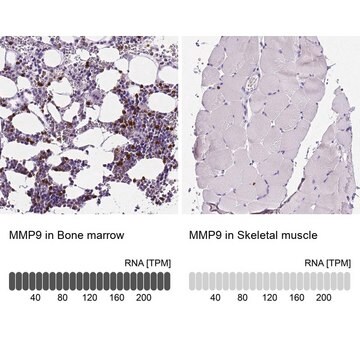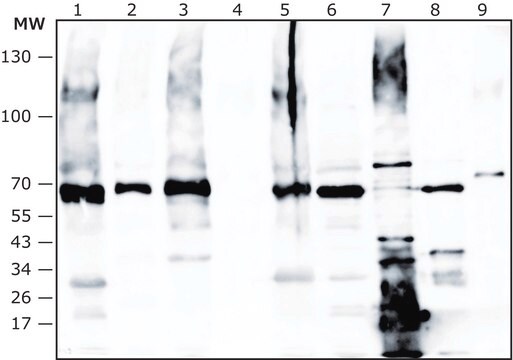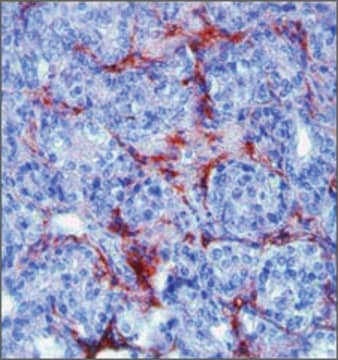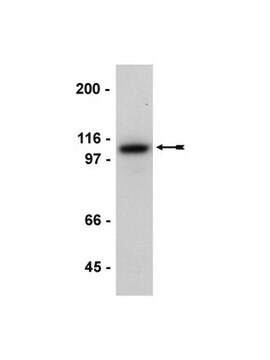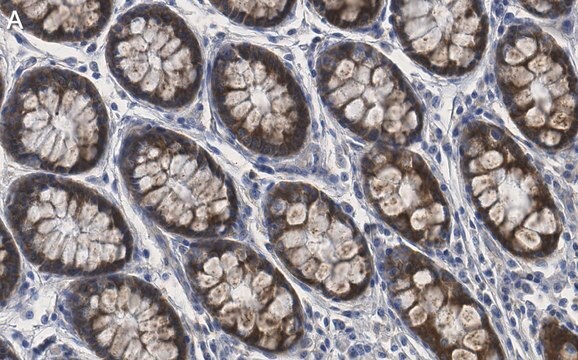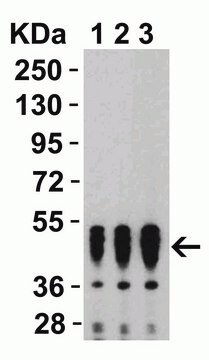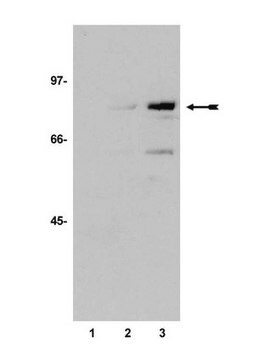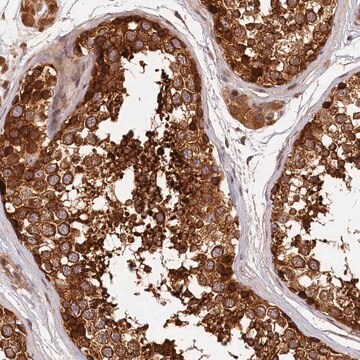Allgemeine Beschreibung
We are committed to bringing you greener alternative products, which adhere to one or more of The 12 Principles of Green Chemistry.This antibody is Preservative-free, produced without the harm or sacrifice of animals and exceptionally stable to allow for ambient shipping and storage if needed and thus aligns with "Waste Prevention", "Designing Safer Chemicals" and "Design for Energy Efficiency".
Click here for more information.
ZooMAb® antibodies represent an entirely new generation of recombinant monoclonal antibodies.Each ZooMAb® antibody is manufactured using our proprietary recombinant expression system, purified to homogeneity, and precisely dispensed to produce robust and highly reproducible lot-to-lot consistency. Only top-performing clones are released for use by researchers. Each antibody is validated for high specificity and affinity across multiple applications, including its most commonly used application. ZooMAb® antibodies are reliably available and ready to ship when you need them.
Spezifität
Clone 8H12 is a ZooMAb® Rabbit recombinant monoclonal antibody that specifically detects Matrix metalloproteinase-9 (MMP-9). It targets an epitope within 19 amino acids from the C-terminal region.
Immunogen
KLH-conjugated linear peptide corresponding to 19 amino acids from the C-terminal region of human Matrix metalloproteinase-9 (MMP-9).
Anwendung
Quality Control Testing
Evaluated by Immunohistochemistry (Paraffin) in human bone marrow tissue sections.
Immunohistochemistry (Paraffin) Analysis: A 1:100 dilution of this antibody detected MMP-9 in human bone marrow tissue sections.
Tested applications
Affinity Binding Assay: A representative lot of this antibody bound MMP-9 with a KD of 8.3 x 10-9 in an affinity binding assay.
Immunocytochemistry Analysis: A 1:100 dilution from a representative lot detected MMP-9 in THP-1 cells.
Note: Actual optimal working dilutions must be determined by end user as specimens, and experimental conditions may vary with the end user
Anti-MMP-9, clone 8H12 ZooMAb®, Cat. No. ZRB2049, is a recombinant Rabbit monoclonal antibody that targets MMP-9 and is tested for use in Affinity Binding Assay, Immunocytochemistry, and Immunohistochemistry (Paraffin).
Zielbeschreibung
Matrix metalloproteinase-9 (UniProt: P14780; also known as MMP-9, 92 kDa gelatinase, 92 kDa type IV collagenase, Gelatinase B, GELB) is encoded by the MMP9 (also known as CLG4B) gene (Gene ID: 4318) in human. MMP-9 is an extracellular or secreted enzyme that is synthesized as inactive proenzyme with a signal peptide (aa 1-19) and an activation peptide (aa 23-93) that are cleaved to generate the active enzyme. It is a zinc-binding enzyme that binds two zinc ions per subunit. MMP-9 contains a conserved cysteine that is present in the cysteine-switch motif and binds the catalytic zinc ion, thus inhibiting the enzyme. The dissociation of the cysteine from the zinc ion upon the activation-peptide release activates the enzyme. Processing of the precursor is reported to yield different active forms of 64, 67 and 82 kDa. It can be present as a monomer or a disulfide-linked homodimer. MMP-9 is produced by normal alveolar macrophages and granulocytes. Macrophages and transformed cells usually produce only the monomeric form. MMP-9 plays an essential role in local proteolysis of the extracellular matrix, in leukocyte migration, and bone osteoclastic resorption. It cleaves type IV and type V collagen into large C-terminal three quarter fragments and shorter N-terminal one quarter fragments. MMP-9 expression is regulated by several cytokines and growth factors. In coordination with other MMPs, it plays a role in normal tissue remodeling events, including neurite growth, embryonic development, angiogenesis, ovulation, mammary gland involution and wound healing. Abnormalities in MMP-9 are associated with a variety of autoimmune diseases, including systemic lupus erythematosus, Sjogren′s syndrome, systemic sclerosis, rheumatoid arthritis, multiple sclerosis, polymyositis and atherosclerosis. This ZooMAb® recombinant monoclonal antibody, generated by our propriety technology, offers significantly enhanced specificity, affinity, reproducibility, and stability over conventional monoclonals.
Physikalische Form
Purified recombinant rabbit monoclonal antibody IgG, lyophilized in PBS with 5% Trehalose, normal appearance a coarse or translucent resin. The PBS/trehalose components in the ZooMAb® formulation can have the appearance of a semi-solid (bead like gel) after lyophilization. This is a normal phenomenon. Please follow the recommended reconstitution procedure in the data sheet to dissolve the semi-solid, bead-like, gel-appearing material. The resulting antibody solution is completely stable and functional as proven by full functional testing. Contains no biocide or preservatives, such as azide, or any animal by-products. Larger pack sizes provided as multiples of 25 μL.
Rekonstituierung
300 μg/mL after reconstitution at 25 μL per vial. Please refer to guidance on suggested starting dilutions and/or titers per application and sample type.
Lagerung und Haltbarkeit
Recommend storage of lyophilized product at 2-8°C; Before reconstitution, micro-centrifuge vials briefly to spin down material to bottom of the vial; Reconstitute each vial by adding 25 μL of filtered lab grade water or PBS; Reconstituted antibodies can be stored at 2-8°C, or -20°C for long term storage. Avoid repeated freeze-thaws.
Rechtliche Hinweise
ZooMAb is a registered trademark of Merck KGaA, Darmstadt, Germany
Haftungsausschluss
Unless otherwise stated in our catalog or other company documentation accompanying the product(s), our products are intended for research use only and are not to be used for any other purpose, which includes but is not limited to, unauthorized commercial uses, in vitro diagnostic uses, ex vivo or in vivo therapeutic uses or any type of consumption or application to humans or animals.

